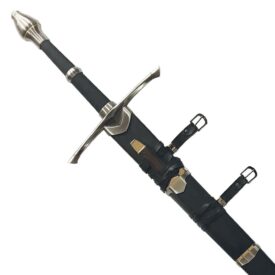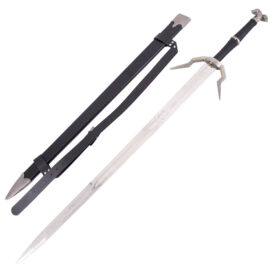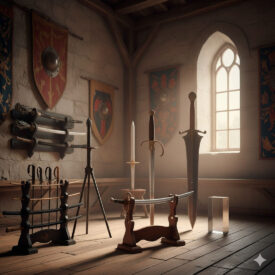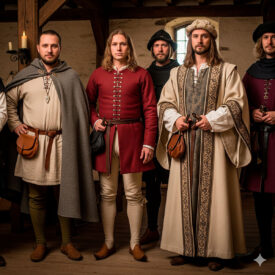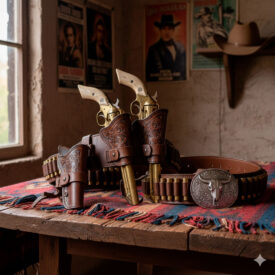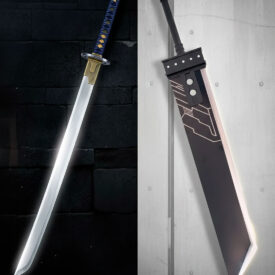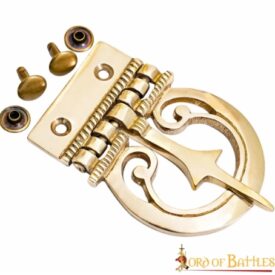What does a headdress reveal about its wearer? Imagine a candlelit room where the silhouette of the hennin stands out like a fabric tower: medieval headdresses not only decorated, but spoke for the wearer, marking status, marital status, and style.
In this article you will discover the historical evolution of headdresses, the most representative types, the materials and construction techniques, and practical tips for choosing faithful replicas for reenactment or events. Here, research and craftsmanship combine to help you recognize and select authentic pieces.
Forms and evolution of medieval headdresses in the Iberian Peninsula and Europe (5th–17th centuries)
The chronology helps to place each form in its context: from simple coifs to the corniform and hennin structures that dominated late Gothic imagery.
| Era | Event |
|---|---|
| Early and Late Middle Ages (5th–12th centuries) | |
| 5th–8th centuries | Simple attire. Single women with loose hair; married women wore a bun and possibly hairpins. In the Carolingian era, headdresses made of pearl threads and veils such as ricinum or mafors appeared for decorum. |
| c. 1000–1250 (High Middle Ages) | The Gebende (frontal band covering head and chin), coifs for ladies, and the Schapel (flower crown or narrow hoop) appear. |
| Late 12th century | The hood separates from the cape and is worn open and loose; it often covers long braids with a veil. |
| 13th Century | |
| 13th century | Continued use of circlets or frontal goldsmithery, galloons and floral decorations reminiscent of ancient ribbons. |
| 14th Century: birth of fashion and structure | |
| Pre-Gothic / Peninsula (14th century) | Representation in the Emilianense Codex (El Escorial) of an elevated headdress projected forward (cone type) associated with Queen Doña Urraca; possibility of Iberian tradition with a “column” on the head. |
| Early 14th century | The hood tightens and the liripipe develops. The templet hairstyle features vertical columns of braids; around 1330 the use of buttons for fitted sleeves became widespread. |
| 1340–1350 | Rapid changes in clothing: rise of the fitted and short male suit and greater differentiation of female dress. |
| Late 14th century | Wire frames for headdresses appear (e.g. eleven frames found in London). Chaucer (c.1374) uses the word caul for fitted caps. First representations of the corniform headdress in the peninsula (Santo Domingo de Silos, c. 1384–1388). |
| c. 1400 (transition) | The templet braids are gathered more tightly, evolving into the caul (net or woven net). The bourrelet (rolled cap) begins to appear as a padded roll, with “falling” variants. |
| 15th Century: dramatic forms and expansion of the corniform | |
| Early–mid 15th century | The cauls widen. The corniform headdress is documented in the nobility of the northern Meseta: church of San Nicolás de Bari in Sinovas (first third of 15th century), Oviedo Cathedral (c. 1412–1441), church of San Pedro in Langa del Castillo (c. 1425), tomb in Santo Domingo de la Calzada (c. 1440) and in Olite Castle (1446) among the maidens of Queen Agnes of Cleves. |
| c. 1440–mid 15th century | In Western Europe, the evolution of cauls into horn or cone shapes gave rise to the conical or truncated hennin; documented heights of up to ~60 cm. These cones usually carry a full veil, often semi-transparent. |
| Until 1450 | The male bourrelet takes hold: hair cut round or “bowl-cut”, with skullcap and padded roll; its use and development continues until 1450 and beyond. |
| Second half 15th century | Choir stalls of León Cathedral (c. 1464–1481) show corniform headdresses. In 1467 a Burgundian chronicler describes women’s hats that narrow above to ½–¾ of an ell. The male padded roll (bourrelet) shows continuous use (documented around 1490). A Gascon drawing (c. 1496–1499) shows a curved corniform headdress worn outside the elite. |
| 16th Century: chroniclers, description and decline | |
| c. 1500–1520 | Church of Santa María la Mayor de Ezcaray (La Rioja): image of Saint Lucy with corniform headdress (c. 1500–1520). |
| 1517 | Laurent Vital describes in Tazones (Asturias) strange, tall female headdresses comparable to “large cherry baskets” or “tall tambourines”. |
| 1525–1528 | Andrea Navagero describes corniform headdresses in Guipúzcoa and Vizcaya, comparing them to hoods with bent tips, like a crane’s beak. |
| c. 1530–1539 | References in Bayonne to “les grants cornes” (Sébastien Moreau, c.1530). Lucio Marineo Sículo (1539) mentions linen headdresses two or three palms high in mountainous regions of Spain. There is a desire among young women to replace them with other couvre-chef. |
| Late 16th–17th centuries: gradual disappearance | |
| 17th century | The corniform headdress gradually disappears from everyday use and fashion; however, according to Edouard Ducéré (1889) in rural areas of Labourd and Bayonne, some elderly women still preserved the “grandes cornes” as cultural relics. |
Types, social language and functions
Headdresses acted as a visible language: a hennin or a corniform headdress announced nobility; a toca or a cofia indicated modesty and marital status. Below you will find a practical guide to the most common types and their meaning.
- Bonnet: Fitted cap, worn by all classes.
- Hat: Regional and functional variations.
- Toca / House Toca: Covered head, neck and shoulders; common in married women.
- Hairnet (caul): Mesh that gathered hair; base for later evolutions.
- Coif: Fine cap, often under other headdresses.
- Hennin: Tall cone with veil, symbol of status in the 15th–16th centuries.
- Corniform headdress: Iberian variant with wicker frame and rolled bands, distinctive in the Meseta and northern regions.
Main functions
- Social identifier: materials and height indicate wealth.
- Indicator of marital status: covering hair was an obligation for married women in many contexts.
- Protection: against weather and dust.
- Ceremonial: in weddings, rituals and religious representations.
Medieval headdresses: replicas and pieces to wear
If you are looking for pieces for historical reenactment, it is advisable to distinguish between replicas intended for stage use and light variants for events; both can be faithful if they respect materials and construction.
The hairnet or caul is usually reproduced in linen or silk and, in replicas, with a wire structure to maintain its shape. It is ideal for recreating 14th–15th century hairstyles and can be combined with veils and headbands.
Materials and construction: rules of authenticity
Materials make the difference between a plausible replica and a generic accessory. Prioritize:
- Linen and cottons for popular and everyday pieces.
- Silk and velvet for noble and decorated pieces.
- Wire or wicker frames to support templets, cauls and corniform headdresses.
- Embroidery and beads only if the historical piece shows it; avoid anachronisms.
Table: materials and historical uses
| Material | Social class | Historical use |
|---|---|---|
| Linen | Popular and ecclesiastical | Hairnets, coifs and everyday veils |
| Silk | Nobility | Elaborate headdresses, embroidery and fine veils |
| Velvet | Nobility | Ornaments and aristocratic coifs |
| Wicker / Wire | All (technique) | Frames for corniforms and hennin |
The presence of metallic threads, pearls and embroidery accentuates the luxurious character; their absence does not detract from the verisimilitude of lower-class pieces if the cut and technique are correct.
Craftsmanship, techniques and hidden details
Behind many headdresses there are invisible structures: wire frames, parchment or wicker bases, and seams that fix veils. Knowing these techniques will allow you to evaluate replicas with criteria.
- Interior structures: check if the frame is consistent with the historical shape (wicker for corniforms; wire for cauls).
- Finishes: hand seams, ribbon trims and linen linings are indicators of quality.
- Weights: a very light hennin may be modern; an excessively heavy one without comfortable support will be impractical in realistic use.
How to choose a headdress for reenactment or event
 Think about the context: specific era, social class and function (ceremonial, everyday or courtly). Avoid mixing elements from different centuries; visual coherence is the key to a good reenactment.
Think about the context: specific era, social class and function (ceremonial, everyday or courtly). Avoid mixing elements from different centuries; visual coherence is the key to a good reenactment.
- Define the target date: 14th, 15th or early 16th centuries have very different forms.
- Choose appropriate material: linen for commoners; silk and pearls for noble ladies.
- Check the structure: visible or interior frame depending on whether it is corniform, hennin or caul.
Meanings, laws and fashion
Headdresses were regulated by sumptuary laws in many kingdoms. The use of colors, silks or ornaments served to prevent imitation between classes and preserve visible hierarchies.
In addition, regional variation adds layers of meaning: the corniform in the northern Meseta is a geographical as well as social distinctive. Foreign chroniclers were amazed by these forms, describing them with metaphors that still help us to identify them today.
Clearing up unknowns about medieval headdresses
What were the most commonly used materials for making medieval headdresses?
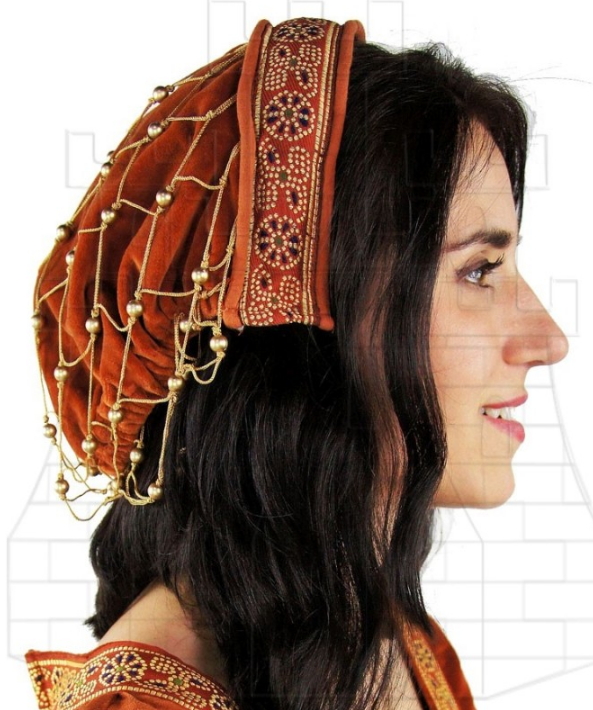 The most commonly used materials for making medieval headdresses were linen, cotton, silk, and velvet. In addition, ornaments made of metal and ceramic were used to give them a touch of elegance and distinction. The use of these materials varied according to social status and the occasion for which the headdresses were intended.
The most commonly used materials for making medieval headdresses were linen, cotton, silk, and velvet. In addition, ornaments made of metal and ceramic were used to give them a touch of elegance and distinction. The use of these materials varied according to social status and the occasion for which the headdresses were intended.
As for embroidered ornaments, cotton threads or similar were used to create characteristic patterns and designs. In addition, materials such as straw could be used on some occasions to complement simpler headdresses.
In general, the chosen materials reflected social position and the importance of the occasion, with the most luxurious ones reserved for nobility and special celebrations.
How did medieval headdresses vary according to social class?
Medieval headdresses varied according to social class mainly in material, complexity and ornamentation. Noble women wore elaborate headdresses, such as the hennin, tall and pointed, adorned with fine fabrics, jewels or furs, clear symbols of high status. Bourgeois women used simpler coifs or veils, while peasant women wore handkerchiefs or very basic pieces. In addition, there were laws that regulated which headdresses could be worn according to social rank to prevent commoners from impersonating nobles. In men, the shape of the headdress also indicated profession or status, such as the biretta for scholars. In addition to status, headdresses reflected marital status and virtue, especially in the case of married women who had to cover their hair for religious reasons.
What ceremonial functions did headdresses fulfill in the Middle Ages?
Headdresses in the Middle Ages fulfilled ceremonial functions primarily as symbols of social status and marital status, differentiating nobility and married women from other social groups. They also had a ritual and symbolic component in certain events, reflecting honor and obedience to moral norms, such as modesty. Additionally, in important ceremonies, headdresses had a symbolic value that reinforced social roles and hierarchies within the context of public or religious rituals and events.
What differences existed between female and male headdresses in the Middle Ages?
 The differences between female and male headdresses in the Middle Ages were significant and reflected both the social status and gender roles of the time:
The differences between female and male headdresses in the Middle Ages were significant and reflected both the social status and gender roles of the time:
Female Headdresses:
- Functionality and Morality: In addition to being fashion elements, female headdresses also served as protection against the sun, wind, and cold, as well as covering hair for modesty.
- Stylistic Variety: They were used from simple veils to elaborate coifs, headbands, hennins, and horned and butterfly headdresses. Married women usually covered their hair with veils, while single women could wear their hair loose or braided under headbands.
- Indicators of Social Status and Marital Status: Headdresses were clear indicators of a woman’s social status and marital status.
Male Headdresses:
- Use and Styles: Male headdresses were not as common or varied as female ones. However, men wore caps and hoods, especially long, pointed hoods, which were popular during this period.
- Practical Functionality: Although not as ornamental as female ones, they served practical functions such as protecting the skull from cold and other weather conditions.
In summary, female headdresses were more elaborate and symbolic, while male headdresses were simpler and more practical.
How did medieval headdresses influence modern fashion?
Medieval headdresses have influenced modern fashion in several specific ways:
- Inspiration in contemporary accessories: Current designs such as pearl headbands, wide forehead bands, and elegant fascinators reinterpret medieval models such as the schapel, the gebende, and the hennin, adapting their shapes and details to modern styles.
- Bridal and runway fashion: Bridal veils and headdresses for special events find their origin in the veils and head ornaments of the medieval nobility, especially in haute couture collections that resort to the spectacular nature and height of these complements.
- Urban and indie trend: Voluminous hats, artistically knotted scarves, and minimalist tiaras in everyday fashion reflect the diversity and distinctive character of medieval headdresses, integrating them as elements of personal style.
| Type | Main Features | Recommended Use |
|---|---|---|
| Mineral oil | High penetration, does not degrade or attract dirt | Regular protection and maintenance |
| Camellia oil | Natural, acid-free, non-volatile | Antioxidant protection, lubrication |
| Lithium grease | Dense, durable, does not evaporate | Extended storage, protection |
- Mineral oil
-
- Main Features: High penetration, does not degrade or attract dirt
- Recommended Use: Regular protection and maintenance
- Camellia oil
-
- Main Features: Natural, acid-free, non-volatile
- Recommended Use: Antioxidant protection, lubrication
- Lithium grease
-
- Main Features: Dense, durable, does not evaporate
- Recommended Use: Extended storage, protection
History and technique converge in each piece: a well-documented headdress is a door to the era you recreate. If you move between historical reenactment and events, always look for temporal coherence and quality materials so that your headdress not only looks good, but also tells the correct story.
VIEW MEDIEVAL HEADDRESSES FOR WOMEN | VIEW MEDIEVAL COIFS | VIEW MEDIEVAL CRESPINES

